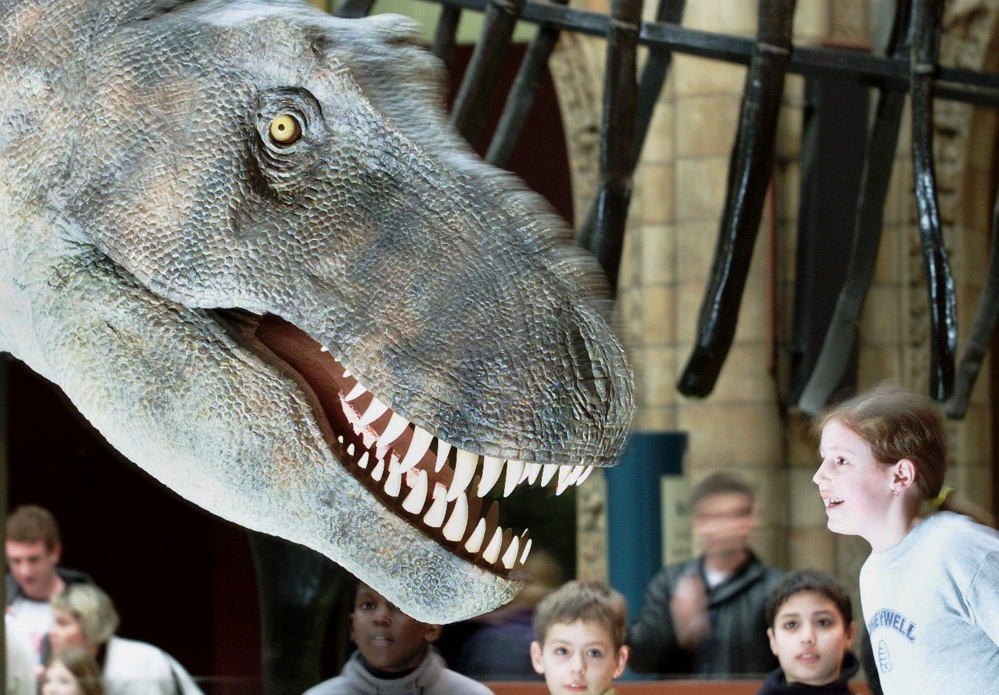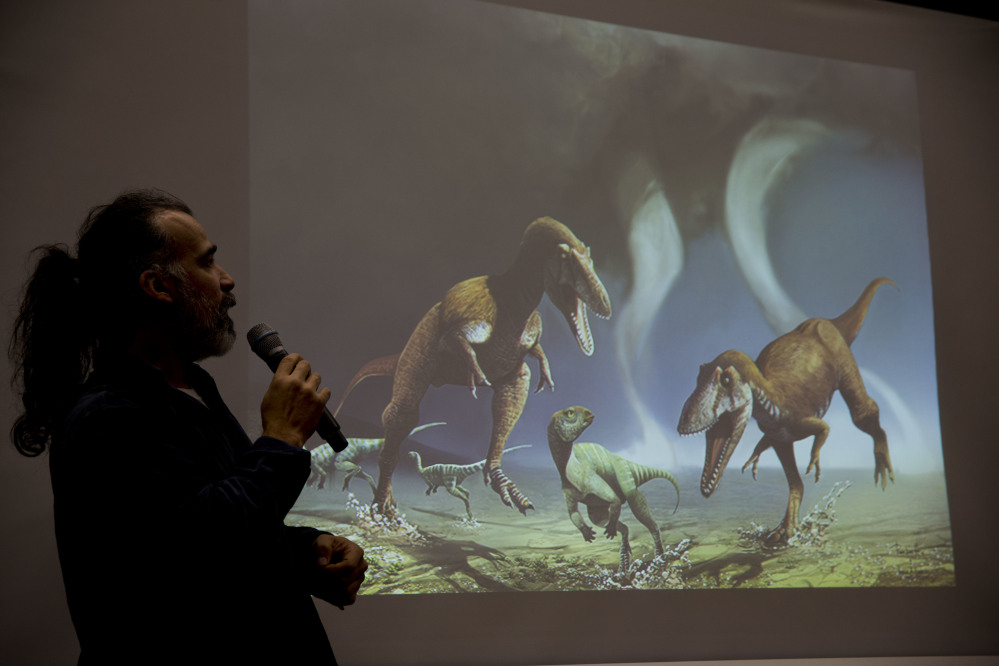Picture, if you will, the mighty Tyrannosaurus rex.
The odds are good what you envision has been brought to you in part by “Jurassic Park,” a plastic toy or some other facet of pop culture. (Perhaps you’re a fan of stop-motion master Ray Harryhausen.) But what Hollywood won’t teach you is that T. rex may have had feathers.
After all, today’s birds are living dinosaurs.
Now listen closely to your fearsome and possibly feathered friend. If you imagine it roaring, as both Steven Spielberg and “The Valley of Gwangi” did, we are sorry to say that sound is complete fiction. The roar of “Jurassic Park”‘s CGI tyrannosaur can be traced to a sound studio rather than the fossil record. It was a witches’ brew of baby elephant cries, tiger chuffs and a gargling alligator, remixed into a cinematically terrifying but completely artificial aural blast.
Were a dinosaur to vocalize in defense of its territory – or as a mating call – it might have sounded like one of today’s birds, scientists say. In fact, a journal article published online Monday argues that the ancient reptiles made sounds closer to the coo of a pigeon or the mumble of an ostrich. Those are far cries from mammalian screams.
‘CLOSED-MOUTH VOCALIZATIONS’
According to the new research, dino sounds may be what scientists call “closed-mouth vocalizations.” Unlike the high-pitched chirps and tweets from the open beaks of songbirds, the closed-mouth sounds are low, throaty whooshes of air. A flesh sac called an esophageal pouch enables birds with proportionally large bodies – think pigeons or doves – to produce the low murmurs.
The researchers figured out the common bird sound like this: First, they collected vocal data on all sorts of animals called archosaurs, which include birds and crocodiles. And, notably, the long-dead dinosaurs. Writing in the journal Evolution, scientists from universities in Texas, Arizona, Utah and Canada analyzed the noises made by many living bird and crocodilian species.
They divided the types of sounds into various groups, including the close-mouth noises. Roughly a quarter of 200 birds species analyzed emitted the bulging closed-mouth sounds. Small birds, like sparrows and finches, did not make the noise. But birds with proportionally larger body types – like doves, ostriches and the giant New Zealand cassowary – do. This, the researchers say, suggest large-bodied dinosaurs may have had similar vocal abilities.
“Looking at the distribution of closed-mouth vocalization in birds that are alive today could tell us how dinosaurs vocalized,” said study author and University of Texas biologist Chad Eliason in a statement.
Moreover, because not all birds had the trait, the scientists say it evolved separately in different groups of animals. It appeared in 16 distinct animal lineages, including crocodiles and birds. The scientists feel confident it could have evolved in dinosaurs, too.
“A cool thing about this work is the demonstration that closed-mouth behavior evolved many times,” Tobias Riede, Midwestern University physiology expert and lead author of the paper, said in a news release. “That suggests it can emerge fairly easily and be incorporated into mating displays.”
The researchers were handicapped in their study because vocal organs, made of soft tissue, do not fossilize the way dinosaur bones do. So it’s much easier to build a big scary creature than to reconstruct what it sounded like.
But there are a few other hints in addition to this study. Based on what scientists know about birds, dinosaurs likely did not have vocal cords – those tough membranes that vibrate when a lion roars or a human speaks. Instead, they had air sacs, and it is possible dinosaurs had a birdlike syrinx, too (an organ similar to our larynxes but two-pronged and lower in the chest).
Like intimidating birds
If a non-avian dinosaur whooshed like a bird, with its throat puffed up, the scientists suggest it may have sounded like the most intimidating large-bodied birds of today: ostriches and cassowaries.
Though ostriches are imposing creatures, their hoots leave Hollywood-trained ears wanting. The ostrich mating call is a low buzz, a sound about as ferocious as the gasps from a dying vacuum cleaner.
That said, the sound-smiths behind “Jurassic Park” were able to call on the dinosaurs’ living cousins in a few tense scenes – just not for T. rex.
As designer Gary Rydstrom told Vulture in 2013, the sibilant velociraptors – specifically, the sounds emitted right before a certain clever raptor ambushes game warden Robert Muldoon – have avian influences.
“That’s a goose,” Rydstrom said to Vulture. “Birds make pretty raspy sounds, but geese are famous for being the nastiest. You’ve got to get a goose mad and then they hiss at you, and it doesn’t take much to get a goose mad because they seem to get mad at everything.”
For creatures that so readily capture both popular imagination and scientific study, much remains unknown about dinosaurs.
Dino sounds are no exception to the mystery. It is safe to say dinosaurs made sounds, as American Museum of Natural History Mark Norell put it. But exact specifics – like certainty of dino whooshes, hoots or coos – died with the animals, 65 million years ago.
Send questions/comments to the editors.




Success. Please wait for the page to reload. If the page does not reload within 5 seconds, please refresh the page.
Enter your email and password to access comments.
Hi, to comment on stories you must . This profile is in addition to your subscription and website login.
Already have a commenting profile? .
Invalid username/password.
Please check your email to confirm and complete your registration.
Only subscribers are eligible to post comments. Please subscribe or login first for digital access. Here’s why.
Use the form below to reset your password. When you've submitted your account email, we will send an email with a reset code.